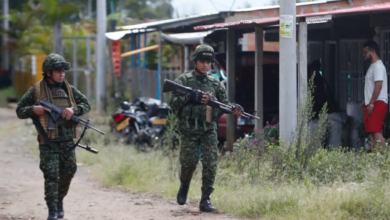Addressing the ‘Nini’ Crisis: Empowering Colombia’s Forgotten Youth

The rise of ‘ninis’—young people neither studying nor working—highlights a growing crisis in Colombia. We must urgently address the systemic barriers preventing them from finding opportunities in education and employment to avoid a generation trapped in vulnerability.
The ‘Nini’ Phenomenon
The term “nini,” shorthand for “ni estudia, ni trabaja” (neither studying nor working), often carries negative connotations, suggesting laziness or disinterest. Yet, the reality is far more complex for countless young people across Colombia. María Rada, a 26-year-old from the outskirts of Bogotá, embodies the challenges faced by this demographic. She arrived from Valledupar five years ago, brimming with ambition, hoping to study psychology at the Universidad Nacional, one of Colombia’s most prestigious public institutions. Despite her determination, she couldn’t secure a spot and has since struggled to find stable work.
María represents thousands of young Colombians whose dreams are not realized due to structural barriers. They are not “ninis” by choice but because of circumstances beyond their control. After briefly working at a stationery store without formal employment rights, María now stays home, frustrated by the lack of opportunities. “They call us ‘ninis,’ but it’s not because we don’t want to work or study. I’ve tried countless times, but the opportunities never came,” she explains.
The growing number of ‘ninis’ is not only a personal tragedy for each individual affected but also a broader societal issue that reflects deep-rooted inequalities. For many like María, life has become a relentless cycle of blocked paths. Without access to quality education, formal employment, or social mobility, these young people are left searching for hope in an environment that offers little more than crime, informality, or precarious survival.
The Systemic Barriers Holding Colombia’s Youth Back
The plight of ‘ninis’ like María and thousands of others in Colombia highlights the significant systemic barriers that young people face, particularly in marginalized communities. Suba, the most populous district in Bogotá where María lives, is emblematic of these challenges. Located on the city’s periphery, it is home to many displaced families, migrants, and vulnerable populations. The lack of essential services, educational opportunities, and stable job markets makes Suba, and similar neighborhoods across Colombia, breeding grounds for the ‘nini’ crisis.
The sobering truth is that in Colombia, it takes 11 generations for someone born into poverty to reach the same financial standing as someone born into the middle class. This generational poverty trap creates a chasm that young people cannot easily cross. While educational institutions like Universidad Nacional offer hope, the limited spaces available make it nearly impossible for young people from poor backgrounds to secure entry. Many of those who do find employment are confined to the informal sector, working without benefits or protections, unable to improve their circumstances or pursue further education.
The system is unrelenting for people like Óscar Daza, another Suba resident who wanted to study physiotherapy. Displaced by violence as a child, Óscar has been forced to work in various odd jobs simply to survive. Despite his passion for education, the university doors have closed for him. With few viable options, many young people in Óscar’s position fall into the trap of criminal activity or gangs, which offer quick money but at a high cost.
Colombia’s youth are being failed by the systems designed to support them. The nation’s pervasive inequality, coupled with a lack of infrastructure in rural and marginalized urban areas, has created an environment where ambition is not enough to escape poverty. Until these barriers are addressed, the ‘nini’ phenomenon will continue to grow, placing an entire generation at risk of being left behind.
Programs Like “Jóvenes en Paz” Are Crucial but Insufficient
While the situation for ‘ninis’ in Colombia may seem bleak, there are glimmers of hope in initiatives like the government’s “Jóvenes en Paz” program. Launched less than a year ago, this program targets young people aged 14 to 28 who are at high risk of being recruited into criminal activities or falling into poverty. By providing these youth with educational resources, job training, and a small monthly stipend (about $230), the program aims to offer an alternative path.
María was recently accepted into Jóvenes en Paz, and she feels hopeful about her future for the first time in years. “It’s not a program for criminals,” she says, dispelling misconceptions about the initiative. “It’s for young people like me, who don’t have access to education or employment, and it helps guide us toward those opportunities.”
Óscar, too, benefited from the program. Before joining, he was involved in community leadership and organizing sports activities for local children. “Jóvenes en Paz” recognized his potential and offered him the support he needed to formalize his efforts, build leadership skills, and continue working with his community.
The program is essential in pulling young people away from dangerous paths. However, while “Jóvenes en Paz” is undoubtedly a positive step forward, it is not a comprehensive solution to the more significant issue. While providing financial aid and training is helpful, it does not address the deeper systemic problems that trap so many young Colombians in cycles of poverty and vulnerability. The program’s reach is also limited, serving a fraction of those in need.
If Colombia truly wants to solve the ‘nini’ crisis, it must go beyond temporary interventions. Structural reforms are necessary to ensure all young people have access to quality education, formal employment, and social mobility. Programs like “Jóvenes en Paz” can serve as a starting point, but they must be part of a larger strategy to address inequality and provide long-term solutions.
Breaking the Cycle
The ‘nini’ crisis is not just a reflection of individual misfortune—it results from a system failing to provide equal opportunities to its citizens. The barriers faced by young people like María and Óscar are not unique to Colombia; they are part of a broader global issue where youth unemployment and educational inequality disproportionately affect marginalized communities. However, Colombia’s situation is particularly urgent given the country’s history of armed conflict, displacement, and social unrest.
To break the cycle of ‘ninis,’ Colombia needs to implement multi-faceted reforms that address its youth’s immediate and long-term needs. Education must be made more accessible, especially for rural and marginalized areas. This includes increasing the capacity of public universities, offering scholarships and financial support, and creating vocational training programs tailored to the needs of the labor market. Additionally, the formal job market must be expanded to include more opportunities for young people, with protections that ensure fair wages and working conditions.
Moreover, Colombia needs to invest in community infrastructure—such as schools, healthcare centers, and recreational facilities—to help prevent young people from falling into the traps of crime and poverty. Initiatives like “Jóvenes en Paz” show that with the proper support, young people are eager to learn, grow, and contribute to their communities. But without systemic change, these efforts will only offer temporary relief.
Finally, it is essential to challenge the stigma surrounding ‘ninis.’ Instead of blaming young people for their situation, society needs to recognize the systemic failures that have limited their opportunities. Public campaigns that highlight the potential and resilience of youth in marginalized communities can help shift public perception and garner support for policies that create real change.
The ‘nini’ crisis is one of Colombia’s most pressing challenges. Young people like María and Óscar represent a generation eager to work, study, and build a future, but systemic barriers and inequalities hold them back. While programs like “Jóvenes en Paz” provide crucial support, they cannot solve the more significant issue.
Also read: Colombian Spy Software Scandal: A Threat to Citizens’ Privacy
To truly address the ‘nini’ phenomenon, Colombia must invest in long-term solutions that provide equal opportunities for all its youth. This requires comprehensive reforms in education, employment, and community development. Only then can Colombia begin to close the inequality gap and empower its next generation to thrive.





